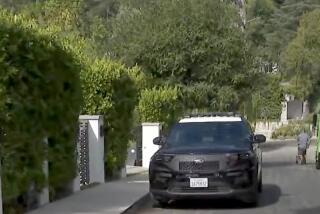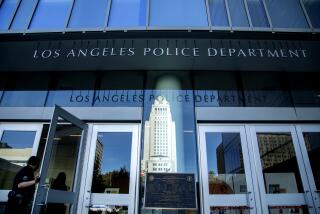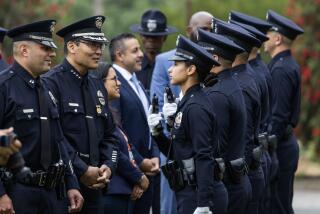Riot Aftermath : Unrest Exposes Training Needs, Top Officer Says : Law enforcement: Deputy Chief Kroeker adds that recent incidents also show community-based policing’s value.
After a week of unrelenting grim news, police in the San Fernando Valley chuckled about a woman who called to report a theft. She had lost the merchandise she took in the frenzy of looting that followed the not-guilty verdicts in the King beating case.
“She views herself as a victim,” marveled Deputy Chief Mark A. Kroeker, police commander for the San Fernando Valley. She and others had “the idea that the ownership of those things is their . . . right in times of chaotic conditions.”
In a wide-ranging interview Tuesday, the Valley’s top cop said the events of the past week tested his faith in people. And he said that although the riots exposed shortcomings in police training, they also showed the value of police fence-mending efforts in the Valley in the wake of the King beating 14 months ago.
Kroeker said the mayhem showed the need for police training exercises to handle a “mob mentality”--whether triggered by riots or natural disasters, such as earthquakes or brush fires.
He credited the community-based policing program with helping reduce the scale of violence in poor neighborhoods of the Valley.
And he returned over and over to a favorite theme: a call for more police to fight crime.
“I hope that in the middle of all the discussion about . . . social rebuilding--the human needs that are there in the city--that there’s room for an understanding that the line is truly thin and it needs to be built up . . . in terms of personnel and their equipment,” Kroeker said.
Although he described himself as an optimist, Kroeker, 48, said his faith in people “has been tweaked” by the chaos that engulfed the city following last Wednesday’s verdicts in the King case.
“I thought we had fewer bad guys,” Kroeker said. “I guess I like to think that we have more decent people than we really do.”
On the other hand, he added hopefully, “as many looters as there were--as large as the criminal population became, or the impromptu criminal population became--it is still a tiny minority of our citizens.”
Since violence erupted the night of April 29, there have been 1,362 arrests in the Valley--including 471 on felony and 891 on misdemeanor charges, a police spokesman said. Many of the latter involved curfew violations.
As of early Tuesday, Valley casualties included three dead and 18 injured, according to the running total. There were also 63 building fires and damage to numerous other structures and vehicles.
However, police cautioned that some incidents--including all three deaths--may not be related to the riots. They said some unrelated incidents that occurred during the rioting may be included in the totals.
Although there were outbreaks of burning and looting Thursday night in the Pacoima-Panorama City-Van Nuys areas, they never approached the rampage that struck South Los Angeles, Koreatown, Long Beach and other areas south of the Santa Monica Mountains.
Kroeker said police in the Valley had a “luxury” that their counterparts didn’t--a quiet Wednesday night in which to marshal their forces. Then a series of quick arrests at looting sites Thursday night helped keep trouble from snowballing in the Valley, he said.
Kroeker also said he thought “community-based policing” had created a reservoir of goodwill that reduced tensions in poor Valley neighborhoods.
“I like to think--and I hope I’m not too self-serving . . . that the positive dialogue that we had with a lot of people in our minority populations, particularly in Pacoima and Lake View Terrace, where the . . . Rodney King incident occurred, reduced the hostility level,” he said.
The program uses a cadre of full-time community liaison officers to increase police sensitivity to neighborhood concerns and create a police-civilian partnership against crime.
Kroeker said that for at least a brief period, police service in the Valley should be at an all-time high. That’s because police are continuing to serve 12-hour shifts and to work through vacation and days off as a precaution against a resumption of violence.
The result, said Kroeker, is “an unprecedented number” of police on duty.
“When people call for service, they’re going to find that on an emergency call we’re going to get there a lot quicker than we have in a long time,” he said.
Usually, because of thin staffing, “we take certain levels of crime and we do virtually nothing on them,” Kroeker said. “Scratch ‘virtually,’ ” he added.
For example, he said, if the only clue in a burglary case is that someone saw the suspect, in normal times “we’re not going to do anything at all.” If police are given the suspect’s license plate number, they might put a little effort in the case.
“We put everything into these levels of priority, and . . . the average person, for the taxes they’re paying, they get shabby service,” Kroeker said.
Despite what he called the “social hemorrhaging” of the city and complaints that police allowed rioting to mushroom by retreating Wednesday night from South Central, Kroeker said the morale of officers is good.
“In a certain way, their morale is very high because they are working together, they feel like they have a unified sense of purpose” and “that ambiguity has been reduced,” Kroeker said. The idea is, “here’s your job, and it’s very clear what your job is.”
Kroeker said he feels this way, too. “I honestly feel more needed than I ever did before.”
More to Read
Sign up for Essential California
The most important California stories and recommendations in your inbox every morning.
You may occasionally receive promotional content from the Los Angeles Times.










